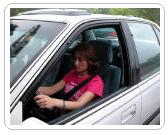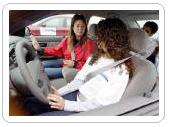|
|
|
|
RISK
TAKING AND RISK PERCEPTION OF TEENAGERS
A. YOUTHFUL RISK TAKING Feeling of immortality, "It can't happen to me" Teens are more likely to take risk because they often have false sense of immortality. Teens perceive automobile accidents as happening to other drivers only. Dangerous behaviors Dangerous behavior, can be defined as any action or lack of action on the part of the driver that increases their risk of a collision. Teens often exhibit dangerous behavior. They more likely to drive faster, make unsafe lane changes, or more likely to make unsafe maneuvers. They often ignore to scan intersection, assuming no possible dangers ahead. False sense of security Young drivers are more willing to take risks compared to other drivers; they are more likely to perceive hazardous situations as being less dangerous than they actually are. Although drivers under age 25 have the fastest simple reaction times, they respond to traffic hazards more slowly than do mid-age drivers, suggesting that they frequently fail to recognize situations as being potentially hazardous. High rate of accidents when taking risks Here are some sobering statistics :
Young drivers' over-involvement in traffic accidents stems from lack of driving experience, exposure to accident risk, alcohol/drug consumption, perceptual abilities, inexperience in identifying and handling hazardous situations, personality structure, internal and external influences, poor judgment, excessive speed, and attitudinal factors such as risk-taking propensity. Showing off for passengers Young drivers often "show off" to impress their friends or others, which can lead to serious injury and death. Exhibition on the road by speeding, weaving your vehicle back and forth, starting out from a signal too fast, peeling out, street racing other drivers, passing dangerously, playing "chicken," and failing to obey signals and the rules-of-the road needlessly causes accidents. Lack of experience and good judgment Although safety is a primary consideration, much of the teenage driver's attention must be devoted to acquiring driving skills, and on learning the rules of the road. New drivers lack the ability to divide their attention between control and safety functions. Teenage drivers in particular, perceive safety as being in direct conflict with their ultimate goal - mobility. Their choice of enhanced mobility, derived from driving at greater speed or in a more daring style, is made more attractive when the risks of detection by the police or involvement in a collision appear small. Young new drivers have a tendency to underestimate reaction time and braking distance and overestimate their capabilities; drivers ages 18 to 24 perceive themselves as being less likely than other drivers their age to be involved in an accident. Young drivers rate certain traffic situations as less risky than do mid-age and older drivers, especially situations involving darkness, graded or curved roadways, intersections, and rural environments. Teens tend to underestimate the danger in high-risk situations and to overestimate the danger in low- to medium risk driving situations. The statistical facts demonstrate that teens do not do a good job of judging their skill level or the dangerousness of driving situations. Willingness to take unnecessary chances Most evidence suggests that the number one factor in young drivers' over-involvement in accidents is risk-taking. Teens who engage in higher-risk activities outside the driving situation tend to have higher traffic accident involvement, whether they are driving or riding as a passenger, suggesting that risky driving may be part of a more general syndrome of risk-taking behavior.
B. RISK PERCEPTION BY YOUNG DRIVERS Lack of perception of unsafe conditions Young drivers often ignore to recognize unsafe conditions caused by weather or traffic or road conditions. Lack of maturity on roads and highways Teen drivers often lack necessary maturity, required for safe driving. As a driver, you must take responsibility for your actions, the actions of your passengers, and for the safe mechanical condition of your vehicle. Driving is a serious responsibility that requires mature behavior. If you can't drive like an adult, stay off the road. Use of higher speeds, tailgating
Young
drivers are know to use higher speeds, tailgating when they feel the person in
front of them is going to slow, etc.
Male vs. female drivers
Teenage
boys have a higher percentage of risky behaviors compared to girls. Of course
there are the exceptions but the boys tend to have more issues with speeding,
racing, risk taking, etc.
"No one got hurt" attitude Teenage drivers may not recognize driving error or near miss as a serious issue if "No one got hurt." They may display very frivolous attitude, not attempting to learn from the driving errors they have made. Poor attitude toward life itself Teenage driver may have poor attitudes toward life itself. They may not recognize how fragile and important is life. As a teenage driver you should know that your life, and the lives of your passengers are in your hands while you are driving. If you act irresponsibly, such as by drinking and driving, you are putting more than just your own life at risk. Think before you act or get behind the wheel.
How to change attitudes It is important that you and the people who teach you how to drive analyze and identify the problem attitudes and behaviors you exhibit while driving. You should constantly monitor yourself while you are driving to identify poor driving habits and attitudes. Once you identify a poor driving habit or attitude, you should substitute it with the appropriate behavior or point of view. You must continuously practice that appropriate behavior or point of view until it becomes automatic. For example, if you recognize that you do not visually-search for hazards, you should remind yourself to do so continually during your driving, until it becomes something you automatically do all the time. You need to repeatedly practice correct responses to hazards while learning how to drive. Remember that only training and practice can overcome poor driving habits and attitudes. Established good driving habits and attitudes can slowly deteriorate over time (drift). In other words, just because you have good driving habits and attitudes now does not mean you will have them in the future. You need to continue to check yourself while driving to identify and correct areas where your habits and attitudes have slipped. Remember to practice doing the correct behavior and having the correct attitude. Only through continued analysis and application of appropriate habits and attitudes can you effectively maintain your good driving habits in the future. Proper training through driver education and training and through practice on the road will make you more comfortable with driving. When you first begin, you will likely be nervous about your ability level. As good driving behaviors and attitudes become automatic through practice, you will be better able to enjoy driving. When you see others who are just learning how to drive, be courteous and remember how nervous you were the first time you got behind the wheel.
Pedestrians and bicycles Teenage drivers may not recognize importance and need to slowdown and take precautions when approaching pedestrians and bicycles. Pedestrians or bicyclists lose in any accident, regardless of who had the right-of-way. Drive cautiously when pedestrians are near and may cross your path. Be especially careful near school zones, residential and recreation areas where you may come across of more children. Children may not recognize danger of traffic and they may suddenly run across the street.
|
 Content
Of Online Course
Content
Of Online Course
